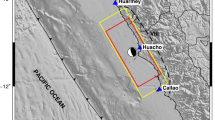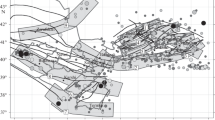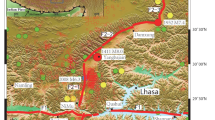Abstract
Great earthquakes of Chinese mainland and its vicinity usually cluster in certain regions during certain periods. We call it major regions of great earthquakes, or major regions briefly in this paper. The major regions of different periods can migrate through long distance in space. We have studied mechanism of formation of major regions. It is proposed that the ductile layer of the lithosphere is the place where the major regions form, and deformation of the ductile layer controls the locations and shape of major regions, and the actions of the plate boundaries around the continent are the main driving forces.
A two-dimensional viscoelastic finite element model is established to model the deformation field and stress field of the Chinese mainland and its vicinity. The boundary of the model is divided into 12 segments to represent non-uniform of boundary conditions. The stress concentration areas in the continental ductile layer are simulated under various compoundings of different boundary segments. Six models are worked out in which the stress concentration regions are consistent with the realistic major regions. It is proved that stress concentration regions can be produced in the ductile layer which are roughly in agreement with the realistic major regions under various actions of different boundary segments.
Similar content being viewed by others
References
Bird P. 1998. Testing hypotheses on plate-driving mechanisms with global lithosphere including topography, thermal structure, and faults [J]. J Geophys Res, 103: 10 115–10 129
DeMets C, Gordon R G, Argus D F, et al. 1990. Current plate motions [J]. Geophys J Intl, 89: 271–280
Ding Guo-yu, Lu Yan-chou. 1986. The principal study of the modern intraplate motion in China [J]. Science Bulletin, 31(18): 1 412–1 415 (in Chinese)
Hong Han-jing. 1994. The dominant tectonic of the earthquake movement in China [J]. Earthquake (Suppl): 102–109 (in Chinese)
Hong Han-jing, Liu Pei-xun, Tao Wei. 1997. The major regions and network of the great earthquake and their variance with time [A]. In: Institute of Geology, China Seismological Bureau eds. The Prediction Research of the Great Earthquakes (1998) [C]. Beijing: Seismological Press, 56–68 (in Chinese)
Hong Han-jing. 1998. The average images of the crust block movements in Chinese mainland and its dynamic sense [A]. In: Editorial Board for Active Fault Research, Department of Science and Technology Development, CSB eds. Active Fault Research (6) [C]. Beijing: Seismological Press, 17–30 (in Chinese)
Huang Sheng-mu, Dong Rui-ying. 1997. The Great Earthquake Active Images and Seismology Prediction in China [M]. Chengdu: Chengdu Cartographic Press, 24 (in Chinese)
Kusznir N J, Bott M H P. 1977. Stress concentration in the upper lithosphere caused by under lying visco-elastic creep [J]. Tectonophysics, 43: 247–256
Ma Zong-jin, Zhang De-cheng, 1986. Plate tectonics and earthquakes [A]. In: Li Chun-yu, Guo Ling-zhi, Zhu Xie, et al eds. Basic Problems of the Plate Tectonics [C]. Beijing: Seismological Press, 363–391 (in Chinese)
Melosh H J. 1976. Nonlinear stress propagation in the earth’s upper mantle [J]. J Geophys Res, 81: 5 621–5 632
Scholz C H. 1990. The Mechanics of Earthquakes and Faulting [M]. Cambridge: Cambridge University Press, 493
Tao Wei, Hong Han-jing, Liu Pei-xun. 1998. The variance of the great earthquake major regions in the Chinese mainland and its vicinity and the hazard prediction of the great earthquake recently [A]. In: Institute of Geology, China Seismological Bureau eds. The Prediction Research of the Great Earthquakes (1999) [C]. Beijing: Seismological Press, 44–54 (in Chinese)
Turcotte D L, Schubert G. 1982. Geodynamics Applications of Continuumphysics to Geological Problems [M]. New York: John Wiley & Sons Inc, 326.
Wang Sheng-zu. 1996. The distinguish of the deformation attribution of the crust and upper mantle [J]. Seismology and Geology, 18(3): 215–224 (in Chinese)
Wang Su-yun, Xu Zhong-huai, Yu Yan-xiang, et al. 1996. The research on the plate reaction force in and near China [J]. Acta Geophysica Sinica, 39(6): 764–771 (in Chinese)
Wen Lian-xing, Anderson D. 1997. Present-day plate motion constraint on mantle rheology and convection [J]. J Geophys Res, 102: 24 639–24 653
Zhang Zhao-cheng, Zheng Da-lin, Wang Gui-xuan, et al. 1994. The non-uniform of the earthquake preparation conditions in the Chinese mainland and the complexity of the earthquake precursory [J]. Earthquake, (Supp): 1–10 (in Chinese)
Zoback M L. 1992. First- and second-order patterns of stress in the lithosphere: The World Stress Map project [J]. J Geophys Res, 97: 11 703–11 728
Author information
Authors and Affiliations
Additional information
Foundation item: National Basic Research Project (G1998-04-07-04) and China Seismological Bureau “95 Climbing Project” (95-04-07-01).
About this article
Cite this article
Tao, W., Hong, Hj. & Liu, Px. Finite element modelling for formation of major regions of great earthquakes in the Chinese mainland and its vicinity. Acta Seimol. Sin. 13, 288–294 (2000). https://doi.org/10.1007/s11589-000-0038-3
Received:
Revised:
Accepted:
Issue Date:
DOI: https://doi.org/10.1007/s11589-000-0038-3




